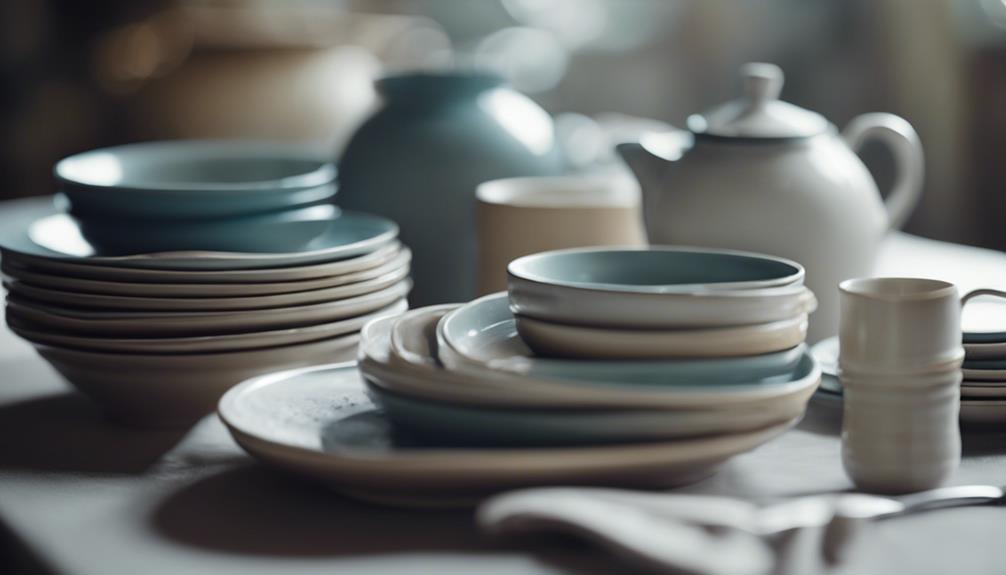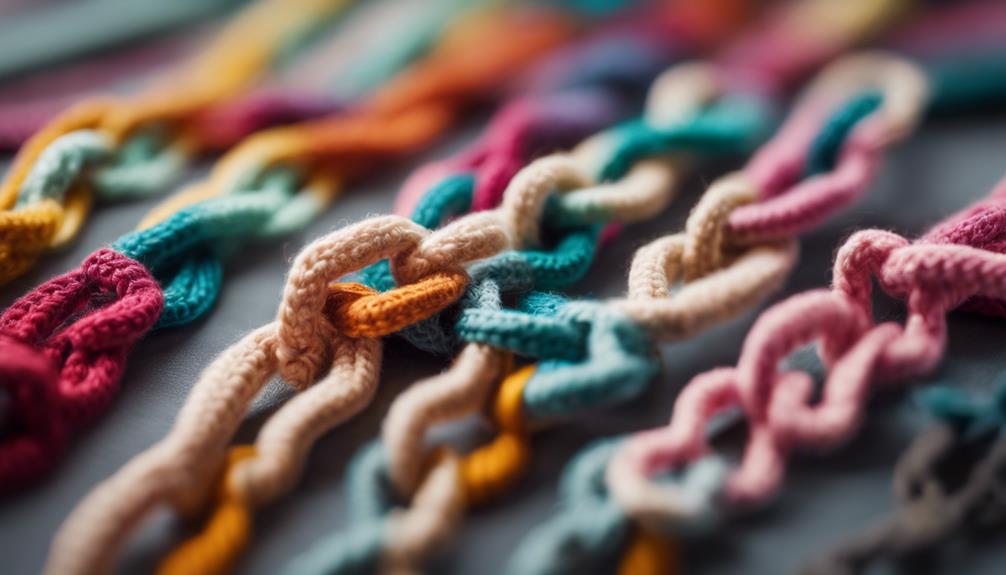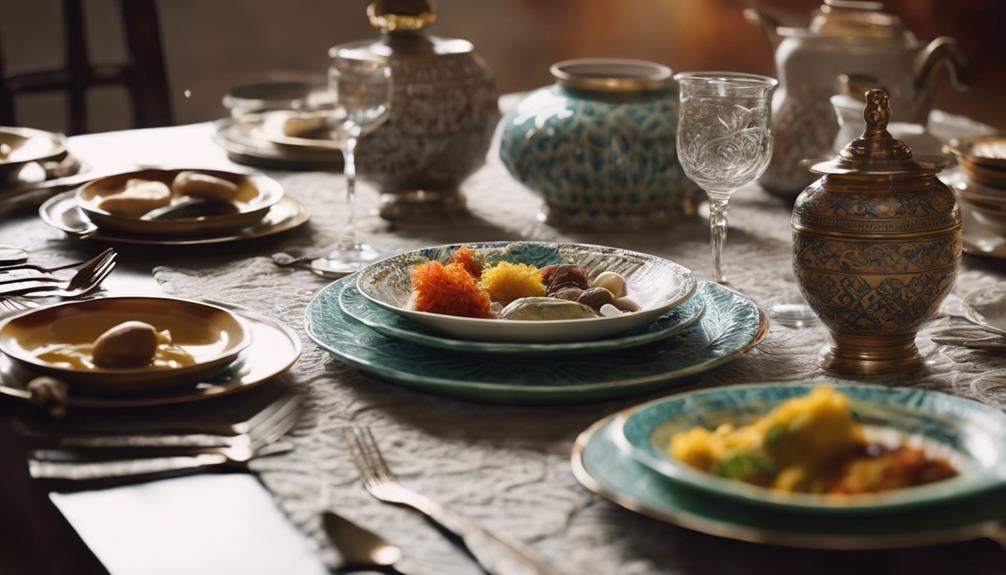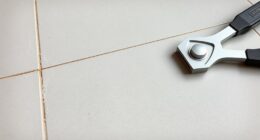Tableware is made from a variety of materials to meet different needs. Porcelain, known for its durability and elegance, is produced from fine-particle clay that is fired at high temperatures. Bone china, a type of porcelain, is light and resistant to stains due to the bone ash it contains. Glassware is extremely durable and nonporous, while stoneware offers hand-painted designs and chip resistance. Silver tableware is elegant and requires regular upkeep to avoid tarnishing. Wooden pieces, often crafted from maple or cherry, add a rustic feel and are environmentally friendly. Plastic options like melamine are heat-resistant and lightweight for outdoor dining. Each material brings its own unique advantages to the table settings.
Key Takeaways
- Porcelain: Refined ceramic material crafted from fine-particle clay, known for exceptional durability and elegant appearance.
- Bone China: Lightweight and translucent type of porcelain made with bone ash and porcelain clay, resistant to stains and odors.
- Glass: Crafted from vitrified glass, nonporous, and virtually indestructible, suitable for dishwasher and microwave use.
- Stoneware: Durable material resistant to chipping and staining, hand-painted designs, safe for microwave, dishwasher, oven, and freezer.
- Silver Tableware: Elegant and valuable, identified by '925' hallmark, requires regular polishing, ideal for formal gatherings and special occasions.
Porcelain
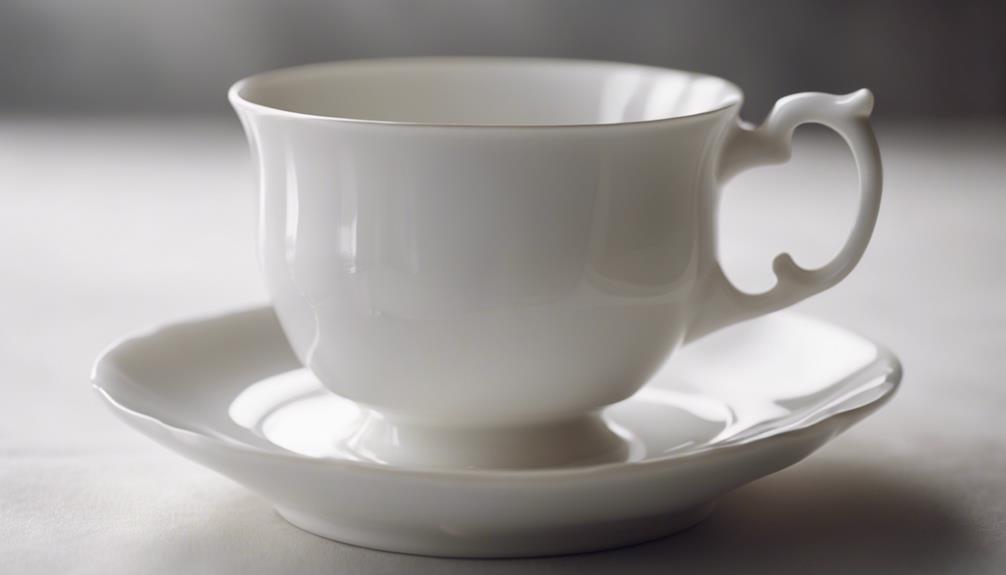
Porcelain, a refined ceramic material, is crafted from fine-particle clay that undergoes high-temperature firing, resulting in exceptional durability and a nonporous surface. This elegant material is known for its exquisite appearance and long-lasting quality. Porcelain tableware is a popular choice for formal dining due to its thin and delicate construction, making it perfect for special occasions.
Bone china, a type of porcelain, is created using bone ash and porcelain clay, producing a lightweight and translucent option for tableware. This type of porcelain isn't only durable but also adds a touch of sophistication to your dining table. Its nonporous nature makes it resistant to stains and odors, ensuring easy cleaning and maintenance. Bone china is a versatile choice, being both dishwasher and microwave-safe, providing convenience without compromising on style.
With its timeless elegance and practical features, porcelain, including bone china, continues to be a favored material for high-quality tableware.
Glass
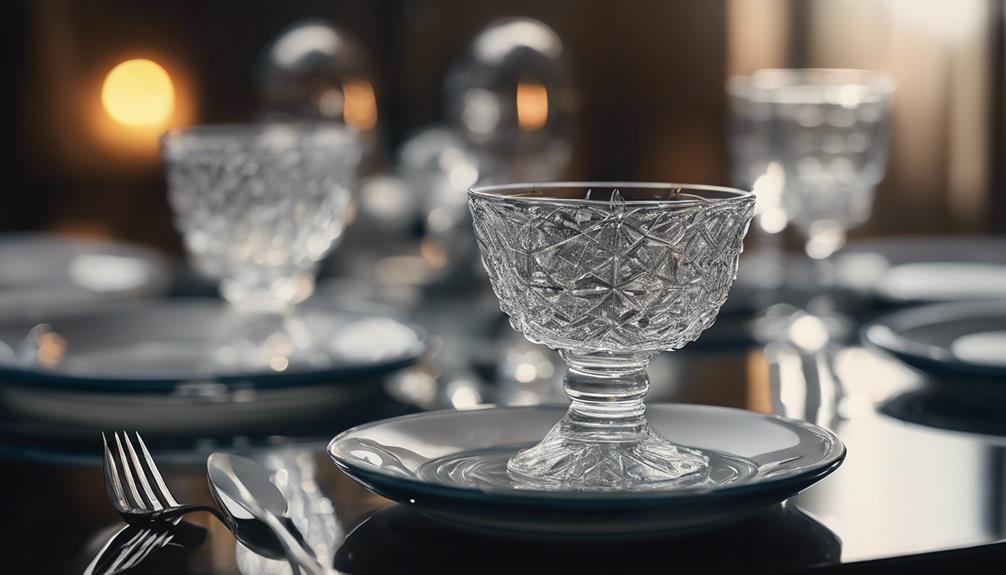
Glass tableware, crafted from vitrified glass fired at ultra-high temperatures for enhanced durability and strength, offers a sleek and modern aesthetic to dining settings.
Brands like Corelle are known for producing glass tableware that's both durable and stylish, thanks to its nonporous and virtually indestructible properties.
The opaque glass laminate of vitrified glass tableware adds a touch of sophistication to your table.
One of the great advantages of glass tableware is its convenience – it's dishwasher and microwave safe, making it easy to care for and use in everyday life.
This type of tableware is popular for its resilience, versatility, and contemporary appearance, suitable for both casual and formal dining occasions.
If you're looking for tableware that combines durability with a modern look, glass tableware might be the perfect choice for your dining needs.
Stoneware
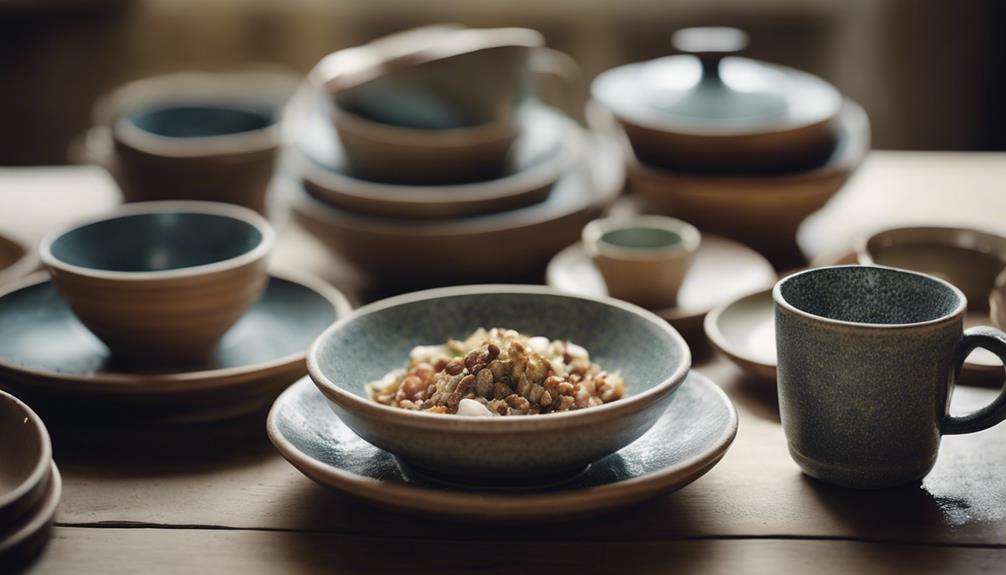
Stoneware is a durable material that can withstand high temperatures, making it suitable for various uses in your kitchen. Its resistance to chipping and staining makes it a practical choice for your dinnerware.
To keep your stoneware in top condition, it's important to handle it carefully and avoid sudden temperature changes.
Stoneware Characteristics Explained
When considering tableware options, one material that stands out for its durability and rustic charm is stoneware. Stoneware is fired at higher temperatures than earthenware, making it resistant to chipping and suitable for everyday use. It can be used in the microwave, dishwasher, oven, and freezer, offering versatility in kitchen settings.
With added vitreous material, stoneware has a more glass-like quality compared to earthenware. The rustic look of stoneware, often hand-painted, gives each piece a unique appeal. To prevent cracking or damage, it's crucial to avoid sudden temperature changes with stoneware.
Its durability, microwave, and dishwasher compatibility, along with the hand-painted uniqueness, make stoneware a popular choice for tableware.
Benefits of Stoneware
What benefits does stoneware offer that make it a popular choice for tableware?
Stoneware is made from different materials and fired at a higher temperature, resulting in a durable and chip-resistant product. This durability makes stoneware a versatile option for everyday use, as it can be safely used in the microwave, dishwasher, oven, and freezer.
The addition of vitreous material during the manufacturing process enhances its strength and longevity, ensuring that it can withstand the rigors of daily mealtime. Additionally, stoneware's hand-painted designs give it a unique and rustic appearance, adding a touch of individuality to your table settings.
Care Tips for Stoneware
To keep your stoneware tableware in top condition, remember to handle it gently and avoid exposing it to extreme temperature changes that could lead to cracks or damage. Here are some care tips for your stoneware:
- Handwash with Care: While stoneware is dishwasher safe, handwashing is gentler and helps prolong its lifespan.
- Avoid Thermal Shock: Prevent sudden temperature changes by letting stoneware cool before immersing it in water or placing it in the oven.
- Use Mild Detergents: Harsh chemicals can damage the glaze, so opt for mild detergents when cleaning stoneware.
- Inspect for Damage: Regularly check for any chips or cracks, as these can compromise the durability of the stoneware over time.
Earthenware
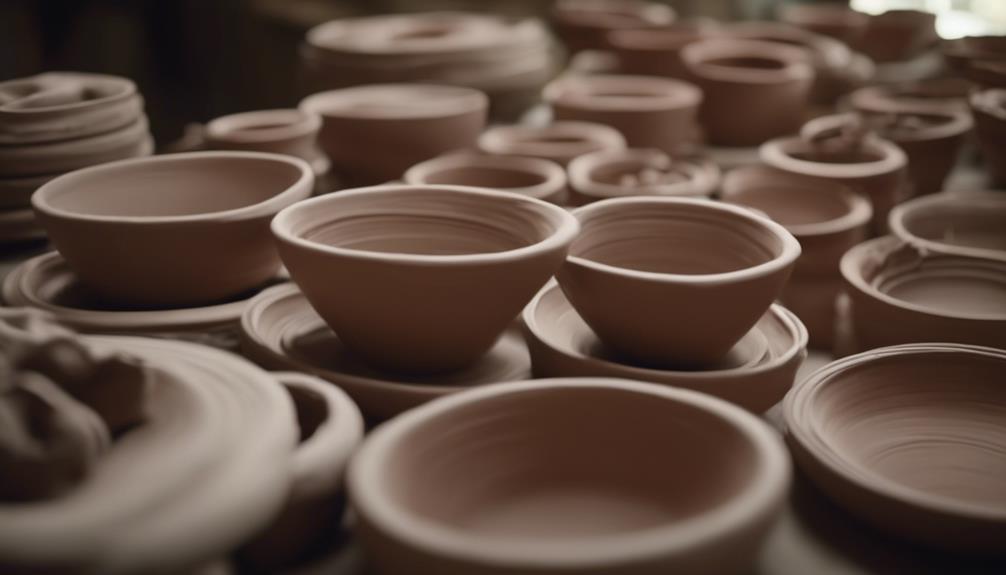
Earthenware, with its rustic charm and affordability, is a popular choice for those seeking unique and budget-friendly tableware. This type of dinnerware is crafted from glazed and fired ceramic, giving it a distinct rustic appearance that appeals to many. One of the standout features of earthenware is that it's often hand-painted, adding artistic designs that make each piece one-of-a-kind.
Due to its porous nature, earthenware is more susceptible to chipping and staining compared to other types of dinnerware. While it's generally safe to use in the dishwasher and microwave, it's important to handle it with care to prolong its lifespan. Manufacturers recommend checking the specific care instructions for each earthenware product, as maintenance methods may vary.
If you appreciate the handcrafted look and feel of tableware and are mindful of your budget, earthenware could be the perfect choice for your dining set.
Stainless Steel
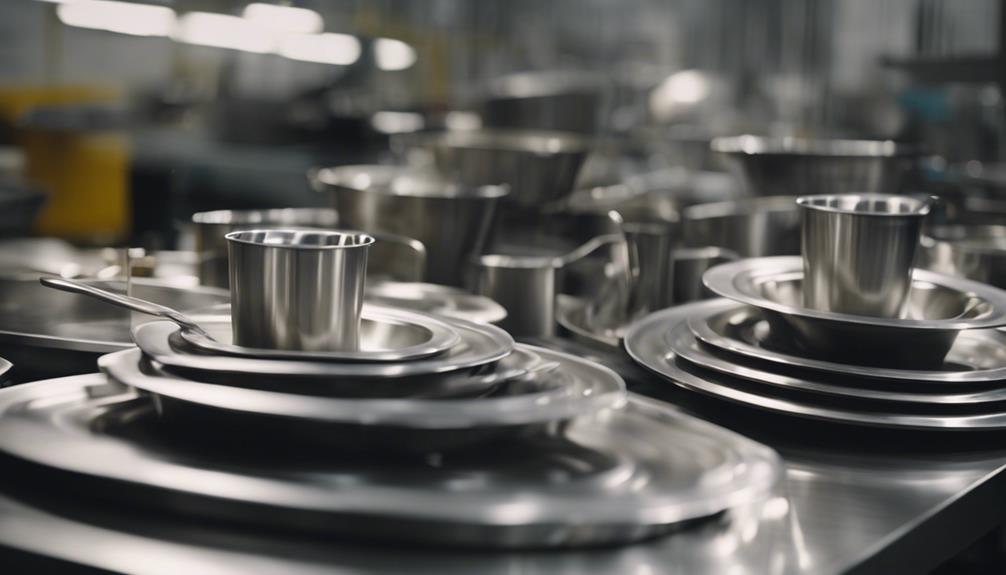
Stainless steel tableware is renowned for its durability and resistance to corrosion, making it a reliable choice for daily use.
Cleaning stainless steel is hassle-free due to its smooth surface and dishwasher-safe properties, ensuring convenience in maintaining its sleek appearance.
In both homes and restaurants, stainless steel tableware offers longevity and hygiene, catering to a wide range of settings with its practical benefits.
Durability of Stainless Steel
Highly durable and resistant to corrosion, rust, and stains, stainless steel tableware is a popular choice for its strength and longevity. Here are some reasons why stainless steel tableware stands out:
- Durable: Withstands wear and tear, maintaining its quality over time.
- Corrosion-Resistant: Doesn't easily succumb to rust or corrosion, even with frequent use.
- Long-Lasting: Maintains its shine and structure, proving to be a lasting investment.
- Dishwasher Safe: Easy to clean in the dishwasher, making it practical and convenient for everyday use.
Stainless steel tableware's durability and practicality make it a cost-effective option for those looking for reliable and long-lasting tableware.
Cleaning Stainless Steel
When cleaning stainless steel tableware, remember to use warm water, a mild detergent, and a soft cloth to preserve its sleek appearance and avoid scratching the surface. Stainless steel is durable and corrosion-resistant, making it ideal for everyday use. It is also dishwasher safe, adding convenience to the cleaning process. Avoid abrasive cleaners or scrubbers to maintain the shine of your stainless steel tableware. Here is a simple guide for cleaning stainless steel tableware:
| Cleaning Method | Benefits |
|---|---|
| Warm water + mild detergent | Preserves sleek appearance |
| Soft cloth | Prevents scratching |
| Dishwasher safe | Convenient cleaning |
Silver
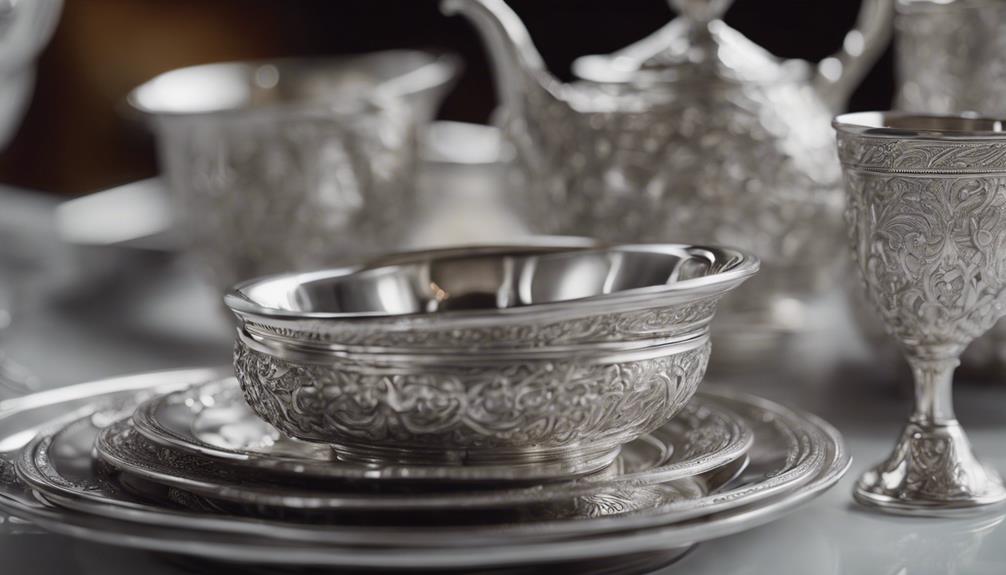
Silver tableware, crafted from sterling silver, exudes timeless elegance and is prized for its luster and durability. Here are some key points about silver tableware:
- Sterling Silver Alloy: Made with 92.5% silver and 7.5% other metals, sterling silver provides strength and durability to tableware items.
- Distinct Luster: The hallmark of sterling silver is its beautiful luster, adding a touch of sophistication to any table setting.
- Hallmark Identification: Look for the '925' hallmark on silver tableware, indicating its sterling silver content and quality.
- Regular Polishing: To maintain its shine and prevent tarnishing, silver tableware requires regular polishing, ensuring it remains a cherished and timeless choice for special occasions.
Silver tableware is a popular choice for formal gatherings, weddings, and upscale events due to its elegance and value. By understanding the unique qualities of sterling silver and the care it requires, you can appreciate the beauty and longevity of silver tableware in your dining experience.
Wood
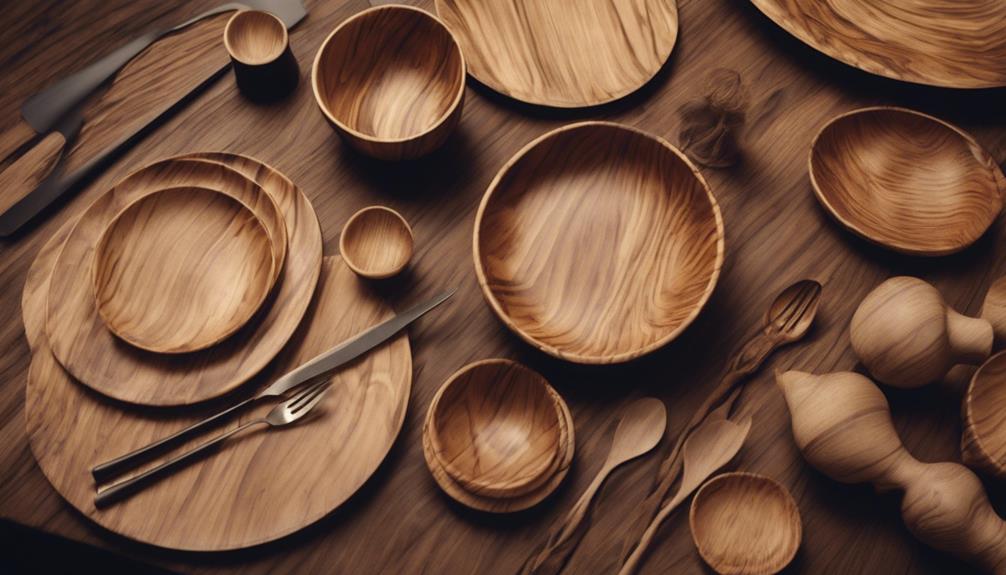
Crafted from various types of wood like maple, cherry, or olive wood, wooden tableware offers a natural and rustic look for your dining experience. Wood is a sustainable and eco-friendly choice for tableware, as it's renewable and adds a touch of nature to your table setting.
Maple, cherry, and olive wood are commonly used for crafting bowls, plates, utensils, and cutting boards, providing durability and style in each piece. To maintain the quality and appearance of wooden tableware, it's recommended to hand wash them and apply occasional oiling.
The warmth and character that wooden tableware brings to your table setting make it suitable for everyday use as well as special occasions. With its unique grains and textures, wooden tableware not only serves a functional purpose but also adds a charming aesthetic to your dining space.
Plastic
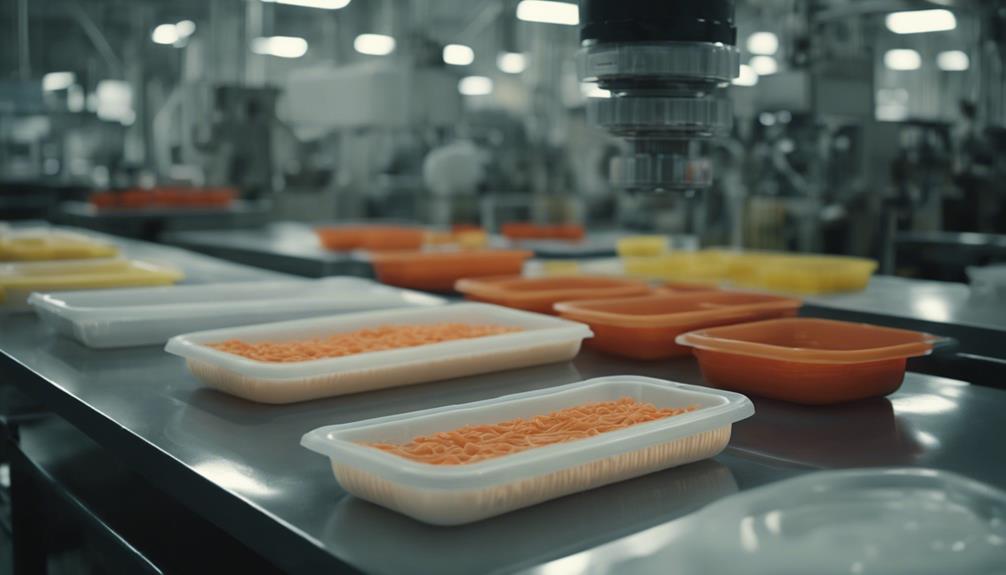
Crafting tableware from plastic materials offers a versatile and practical option for various dining settings. Plastic tableware is commonly made from materials like polystyrene, polypropylene, or melamine.
Here are some key points about plastic tableware:
- Durability: Melamine plastic tableware is popular for its durability, making it a long-lasting option for everyday use.
- Heat Resistance: Melamine plastic tableware is heat resistant, allowing it to withstand hot food and beverages without warping or melting.
- Lightweight: Plastic tableware, including polypropylene items, is lightweight, making it easy to transport for outdoor dining, picnics, and events.
- Variety: Plastic tableware comes in a wide range of colors, styles, and designs, catering to various preferences and occasions while being reusable and dishwasher safe, reducing single-use plastic waste.
Frequently Asked Questions
What Is Most Dinnerware Made Of?
Most dinnerware is made from materials like earthenware, stoneware, bone china, porcelain, or melamine.
Each material has its own advantages, such as durability, elegance, versatility, and lightweight design.
For formal dining, porcelain and bone china are popular choices due to their sturdiness and classy look.
Stoneware is ideal for everyday use and cooking, while melamine is perfect for outdoor dining or kids' settings.
Different materials cater to various preferences and dining needs.
What Material Are Plates Made Of?
Ever wondered what material plates are made of? They come in various types like ceramic, porcelain, bone china, glass, and melamine.
Each has its own unique features and benefits. Ceramic is durable and versatile, perfect for everyday use. Porcelain, on the other hand, is thinner and more delicate, great for formal dining. Bone china is lightweight and translucent, known for its durability. Melamine is lightweight and unbreakable, making it a popular choice for outdoor gatherings.
What Are the Components of Tableware?
Tableware encompasses dinnerware, serveware, silverware, and drinkware, serving various dining needs. Each component plays a crucial role in setting the table for meals.
Dinnerware includes plates and bowls, serveware comprises platters and bowls, silverware involves cutlery, and drinkware consists of cups and glasses. These elements collectively contribute to the functionality and aesthetics of your dining experience, catering to different occasions and preferences.
What Is the Difference Between Tableware and Dinnerware?
When considering the difference between tableware and dinnerware, it's essential to recognize that tableware includes all items for table setting, while dinnerware specifically focuses on plates, bowls, and portioned serving pieces.
Tableware encompasses a wider range of items like serving platters and utensils, whereas dinnerware is limited to dining essentials.
Understanding this distinction helps in choosing the right pieces for various dining occasions based on their specific functions and purposes.
Conclusion
Overall, tableware can be made from a variety of materials such as porcelain, glass, stoneware, earthenware, stainless steel, silver, wood, and plastic.
Surprisingly, a study found that over 70% of households in the United States prefer using tableware made from porcelain due to its durability and timeless elegance.
Each material has its own unique features and benefits, catering to different preferences and needs. Consider the material that best suits your style and usage before making a purchase.
